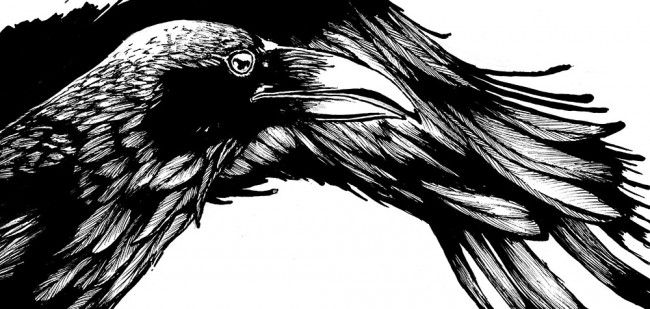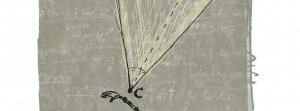
Photo Credit: Facundo Gastiazoro
How Raven found his lunch: Stories across cultures of an eternally hungry bird
Corvus corax. We-gyet. Trickster.
The many names we have for the common raven reflect all the angles of our fascination for the creature. Known for its intelligence, problem-solving abilities and the tendency to get into trouble, we are drawn by its mystery and, perhaps, by a sense of kinship.
The Gitxsan have as many stories about raven as there are stones in the Skeena River. These stories pass on observations of raven behaviour and provide insight into our own human flaws and follies, including pride, greed and vanity. Many stories tell an act of creation—how raven made the sun and stars or how he made the rivers. And many stories feature raven stealing food.
“We-gyet (Raven) never does anything from the goodness of his heart,” Dr. M. Jane Smith cautions. “He might do something that ends up being good for people, but that’s not his intention.”
In many stories, We-gyet has the ability to take human form and plays tricks on people and other animals alike. A researcher, educator and storyteller living in Hazelton, Smith is a fluent Gitxsan speaker and tells We-gyet stories as they’ve been told to her: “We-gyet, he’s always looking for his next easy meal,” she smiles, starting off the story of Raven and Salmon, “and he never wants to do the work…” (See inset for story.)
Constable. Conspiracy. Unkindness.
Across cultures and generations, our collective fascination with raven has persisted. The field of animal behaviour has provided some scientific insight into why these old labels and stories ring true.
While watching ravens one winter near his camp in Maine, researcher Bernt Heinrich noticed a peculiar phenomenon. He observed that when a lone raven came across an animal carcass, it would call out noisily, attracting the attention of other ravens. Since food is scarce in winter, he wondered why these birds would call out to others, increasing the competition for food. One carcass could easily feed one or two birds all winter, and sharing would not be advantageous. Even if no others came at that moment, the following day up to 50 ravens would descend on the carcass, suggesting that the original raven had told its friends about a feast nearby.
This telling of an object that is not present is known in scientific terms as displacement and is known to be shared only by bees, ants, humans and ravens. Eager to solve the mystery of the sharing ravens, Heinrich spent many cold days in a blind, watching ravens and taking notes. Eventually, he discovered an interesting interplay between territory, dominance and the ravens’ language. The ravens that would call out and share were juvenile birds unable to defend a carcass from the adult ravens that held that territory. Young ravens that had not yet established themselves and struggled to hold a territory would fly long distances to find food. When they found something, they would tell their friends and create a posse of other hungry youngsters that would overwhelm the dominant adults holding that territory, forcing them off their rightful food.
In this way, younger ravens that would otherwise go hungry co-operate with each other to steal food from their elders. The full telling of this story can be read in Heinrich’s book, Ravens in Winter.
Interminable trickster
Hearing these stories brings other tall raven tales into focus. A raven repeatedly dropping sticks on horses in a field is probably an attempt to scare them off their grain long enough to gobble it down. Watching a raven fly dead centre down an empty road or railway track likely indicates it’s looking for fresh road kill, not dutifully following Drive BC directions to the next town. Large groups of ravens gathered on a playing field are not just being social; they are eating up worms that surfaced from the last rainstorm. If a raven is doing something you can’t quite explain, it probably has to do with its next crafty scheme for lunch.
It doesn’t matter whether these stories are passed down through the generations, printed in a scientific journal or shared between neighbours over the fence. Whether it is true admiration or just a grudging acknowledgement, we have to admit the inky bandit has genius. Next time you tidy the trash strewn about in the driveway and re-bungee the garbage can, don’t blame the dog. Instead, look at the sky and say, “We-gyet, I always knew it was you.”
The story of Raven and Salmon
One day, like many days, We-gyet was hungry. It was a great day, a beautiful day. He wonders, “How will I get my next meal?” He has an idea, and he changes into his human form, and walks down to the river. He says, “Hey, Salmon! Do you want to play a game? It’s called Guxw good’y mi’lit’—charge at my heart. You are so strong, you will probably beat me.”
Salmon is flattered by the compliment and is excited to play the game. But, before they start playing, We-gyet takes a rock and hides it in his raven cloak. Because he doesn’t know how to fish or set a net, or do any real work, he needs to be creative.
When the rock is safely hidden he says to Salmon, “Guxw good’y mi’lit’—charge at my heart!” Salmon jumps up and charges toward We-gyet. We-gyet falls back, splashing in the river. “Oh, you got me! You are so strong and brave! Let’s play again!” And Salmon, now very proud of himself, charges at We-gyet again.
They continue to play the game and on the fourth time, Wy-gyet slips the rock from underneath his raven robe and hits Salmon. With his last breath Salmon says, “I always knew it was you, We-gyet,” which is what everyone says when they see that We-gyet has tricked them.
Now, We-gyet has this beautiful salmon and he walks up the shore with it and he realizes he doesn’t know how to cook and so he asks his father. His father laughs and says, “Go and ask your poop,” because it is a question that can’t be answered. So he takes it literally and the next time he takes a bowel movement, he asks it how to cook the fish. Amazingly, in a small voice, he hears the instructions: “You dig a pit and lay rocks in it; build a fire; lay the salmon on the rocks, cover the pit and leave the tail out. When it disappears you know the cooking is done.”
When the cooking is done, his brother the crow comes along to admire the salmon. Crow says, “That’s really fine cooking. It deserves a really beautiful tablecloth.” We-gyet says, “Yes, it is very fine, go and get your nice tablecloth.” The crows get little bits of bark and twigs and lay them on the ground. Raven says, “That’s not a good tablecloth. I’ll show you a good tablecloth.”
So he leaves his salmon and goes to get a fine tablecloth made of woven cedar. He comes back and sees that the crows have tricked him and eaten up all his fish. We-gyet is so angry that he kicks the crows in the rear end, and that’s why today crows walk with such an awkward gait.
But what he didn’t realize is that because he’s brother with the crow he also hurt himself—which is why Raven walks that way too. To this day, fishermen enjoy the fight with Steelhead, thanks to Raven and his game, “Charge at my heart.”
Dr. M. Jane Smith




